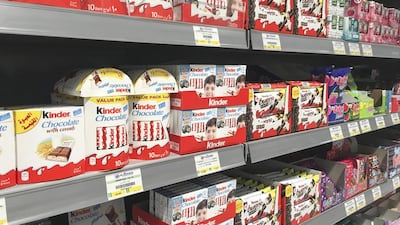DUBAI // Nutritionists have poured cold water on the Kinder chocolate scare that erupted after a watchdog said an ingredient was carcinogenic.
Parents who were worried that mineral oil aromatic hydrocarbons were being passed on to children through the chocolate are being reassured after the alarm was raised by German watchdog Foodwatch.
While advising against overindulging in chocolate, health experts say the risk from hydrocarbons is low in a balanced diet.
Indian nutritionist Rimjhim Sharan said mineral oils could be hard to avoid but parents should not worry about the small levels found in chocolate.
“These mineral oil mixtures can accumulate and damage the liver and lymph nodes,” Ms Sharan said. “However, the proportion of hydrocarbons in a chocolate bar is too little to pose any significant danger.
“Some chocolates may be contaminated, so it is best to restrict their intake. But since the amount of mineral oil found in each bar is low, there’s no need to completely avoid them.”
Kinder products are made by Italian confectioner Ferraro, which was quick to reassure the Ministry of Economy after it said it was watching closely in case a product recall was needed.
Ferraro guaranteed that its products complied with all food-safety requirements, and refused to withdraw Kinder Riegel bars from sale in Germany.
Hydrocarbons are found in other dry foods such as flour, semolina, rice, bread crumbs and breakfast cereals.
Foodwatch tested 15 different chocolate bars and cereals and five different brands of potato chips for the substance.
Eight of the 20 products had moderate to high levels, between 2 and 5 milligrams a kilogram. For a child weighing 10 kilograms, the average daily intake is thought to be up to 3mg/kg.
“The main source of contamination is from the packaging industry,” Ms Sharan said. “It has to be dealt with at the manufacturing level, so it is not really in the hands of consumers.
“No toxicological data is available on the assessment and setting of limit values. As consumers we cannot presume any safety level. They are very common and are likely to have carcinogenic potential and may cause liver damage.”
Rashi Arora, chief nutritionist at the Protein Bakeshop in Dubai, said: “Eating food close to its natural, original form is the best way to keep off any of these nasty ingredients.
“Most hydrocarbons are found in highly processed chocolate and food packaging. Additives and nasty processing methods [can be] used to process breads and grains. Some are also found in cosmetics.
“Sometimes it could be present in food just because of the cardboard used for packaging.”
Recycled newspapers used as food packaging often contain hydrocarbons, which seep into the food chain through newspaper ink and are difficult to remove during processing.
“Most hydrocarbons can damage us at the DNA level only after they are metabolised by enzymes in our body through a process called bio-activation,” Ms Arora said.
“Each of us has a unique metabolism and enzyme bank that may trigger cancer-forming compounds when exposed to hydrocarbons. Plus the food products that they are found in are inflammatory and can lead to a lot of auto-immune issues.”
nwebster@thenational.ae


